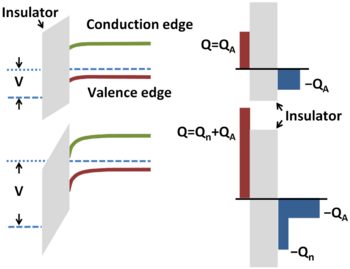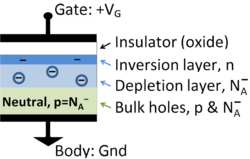User:John R. Brews/Draft: Difference between revisions
Jump to navigation
Jump to search

imported>John R. Brews |
imported>John R. Brews No edit summary |
||
| Line 1: | Line 1: | ||
<br> | <br> | ||
{{TOC|right}} | {{TOC|right}} | ||
{{Image|MOS Capacitor.PNG|right|250px|Cross section of MOS capacitor showing charge layers}} | |||
==MOS Capacitor== | |||
The '''MOS capacitor''' or '''metal-oxide semiconductor''' capacitor is a two terminal device consisting of three layers: a metal ''gate'' electrode, a separating insulator (often an oxide layer), and a semiconducting layer called the ''body''. The device operates using the [[field effect]], that is, the modulation of the surface conductivity of the semiconductor body by means of an applied voltage between the gate and the body. | |||
== | ==Operation== | ||
{{Image|Seimiconductor band bending.PNG|right|350px|''Field effect'': Top panels: An applied voltage bends bands, depleting holes from surface (left). The charge inducing the bending is balanced by a layer of negative acceptor-ion charge (right). Bottom panel: A larger applied voltage further depletes holes but conduction band lowers enough in energy to populate an inversion layer.}} | |||
: | |||
==Notes== | ==Notes== | ||
<references/> | <references/> | ||
Revision as of 11:05, 19 January 2011
MOS Capacitor
The MOS capacitor or metal-oxide semiconductor capacitor is a two terminal device consisting of three layers: a metal gate electrode, a separating insulator (often an oxide layer), and a semiconducting layer called the body. The device operates using the field effect, that is, the modulation of the surface conductivity of the semiconductor body by means of an applied voltage between the gate and the body.
Operation
(CC) Image: John R. Brews
Field effect: Top panels: An applied voltage bends bands, depleting holes from surface (left). The charge inducing the bending is balanced by a layer of negative acceptor-ion charge (right). Bottom panel: A larger applied voltage further depletes holes but conduction band lowers enough in energy to populate an inversion layer.
Field effect: Top panels: An applied voltage bends bands, depleting holes from surface (left). The charge inducing the bending is balanced by a layer of negative acceptor-ion charge (right). Bottom panel: A larger applied voltage further depletes holes but conduction band lowers enough in energy to populate an inversion layer.
